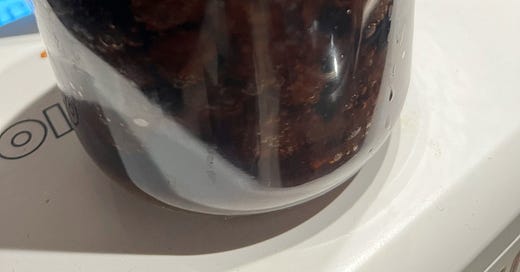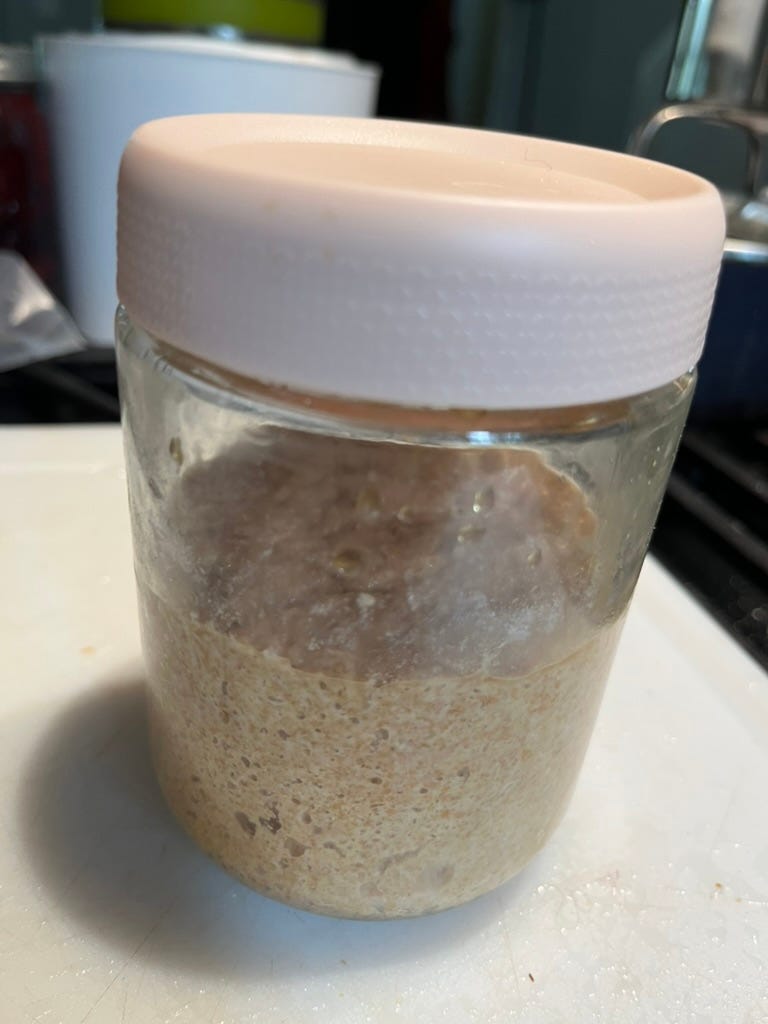This is somewhere between standard bread yeast and sourdough; much less acidic & tangy than sourdough, but with lovely natural yeast flavors, allowing the taste of the flour to come through well. It could be used to seed a sourdough starter if you wish.
80-100 g raisins (unsulfured, uncoated; I used a local grocery store (Hannaford) brand of organic raisins that had hardened beyond edible texture in closed storage, & they worked fine.
250 g room temperature water (Britta filtered &/or sit out overnight if your tap water is chlorinated; I have good local spring water).
(Some recipes suggest adding sugar, but I just rely on the natural sugars in the raisins, which is totally adequate & may even work better; too much sugar actually retards yeast growth).
Add raisins & water to a sterilized jar; close with lid & shake.
Sit at room temperature (68-74 F) for 4-6 days, opening the jar for fresh air, resealing & shaking daily.
For the first 3 days, you’ll only see the raisins hydrate & swell & not much seems to be going on. By day 4 you’ll see fine bubbles covering the raisins & they’ll float to the surface. Opening the jar, there’ll be some fizzing, & a lovely yeasty odor. Use at 4-6 days.
The ferment will involve a mix of natural yeasts & bacteria that resided on the grape skins, dominated by wild strains of Saccharomyces cerevisiae, common beer/bakers’ yeast.

Strain & discard the raisins, or use them in raisin bread; the strained water may be stored in the refrigerator if not used straight away; if refrigerated, allow to warm & wake up before use. A small amount of prepared raisin water may be used to kick-start a subsequent batch, accelerating the process.
Raisin Water Poolish starter:
Stir together equal parts by weight of strained 5-6 day raisin water & flour (use 20-50% of the flour in your bread recipe; I use half the flour of my recipe, so 80g; I use all whole wheat flour at this step; a high-gluten flour is best, as the fermentation will degrade gluten). I’ve tried adding diastatic barley malt extract at this point; the Poolish with diastatic barley malt extract was very active, but as it has a long time to act added this early, the dough turned out too slack; I did like the strong red carmelization of the crust; but best to add this in the final dough prep if used at all. The long preferment allows the diastases & proteases in the flour or barley extract to break starches down to maltose & glucose, & to break down gluten. Sprouted wheat flour has more diastatic activity than unsprouted, & works well here, but unsprouted is fine, may just take a bit longer. If dough still turns out too slack, use a smaller percentage of Poolish in your recipe.
Cover, and allow the Poolish to ferment at room temperature (68F) for 12 hours, overnight; will be spongy with a strong yeasty odor. Use while still active, before it collapses. May be refrigerated & used after returning to activity on re-warming.
For my standard whole wheat bread recipe, add 40g room temperature water to the Poolish to help release from jar; total water will = 80+40 = 120g.
(I use my standard whole wheat bread recipe, modified to use a Poolish starter rather than a sponge).
Combine Poolish & added water with 80g flour for a 75% hydration dough; add other bread recipe ingredients (3/4 tblsp honey, 1/6 c dried whole milk powder, 3/4 tsp salt, 1/2 tsp diastatic barley malt extract if desired, 1/2 tsp sunflower lecithin if desired, for my standard recipe); mix & knead; knead in 1 tbsp softened unsalted butter once a firm dough is formed.
Bulk ferment & proofing will take longer than when using bakers’ yeast, similar to a sourdough dough; but may be hastened if you wish by supplementing with 1/2 tsp instant bread yeast kneaded into the dough; sounds like this is defeating the purpose, but you’ll still benefit from the flavor the raisin water Poolish provides. In white breads the anthocyanin pigments in the raisins may discolor the bread a pinkish/purplish hue; I don’t notice any color change in my whole wheat breads.






If my bread baked up pinkish/purplish I'd consider it the RIGHT color....never dis-colored LOL! (That description of color-maybe could be the reason I experiment with Raisin starter